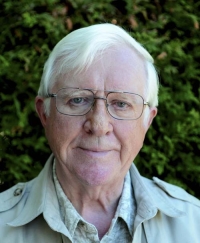
Edward Paul Holubowich grew up on an Alberta farm, the youngest son of Polish immigrant parents. He attended small country and village schools, graduating from Bon Accord High School in 1951, and from the University of Alberta (B.Sc. - Agric.) in 1955.
For two years, Holubowich taught horticulture at the Olds School of Agriculture, then “chose the road less travelled”, he said, and followed the footsteps of fellow agriculture graduates Victor Chanasyk and Roman Fodchuk, to the University of California’s newly-formed School of Environmental Design at Berkeley.
By 1960, he had earned his BLA, and headed to Ottawa to join the Canadian National Parks Branch under Otis Bishopric. Holubowich travelled the country, designing national historic sites, park building sites, and fully serviced campgrounds. In the process, he developed an innovative “cluster campground” concept, configuring large-scale campgrounds on a pinwheel principle to accommodate more treed, private sites along fewer dusty roads.
In 1964, Holubowich moved to the National Capital Commission to design urban and regional parks, parkways and federal building sites. By 1971, he was made Chief Landscape Architect, a post he held for an eventful 18 of his 28 years with the Commission. Holubowich led a staff of landscape architects and consultants to design and implement hundreds of projects arising from the ambitious National Capital Masterplan prepared by French planner Jacques Greber. These were “exciting and demanding times,” Holubowich recalls. The Greber Plan, approved by government in 1956, would ultimately cost $250 million tax dollars to implement.
While he enjoyed design, Holubowich’s main strengths lay in program definition and staff supervision. Holubowich set the priorities and the budgets, and assigned projects to ensure design excellence and on-time delivery.
On the occasion of his retirement, Michael Hough spoke of his rare talents and dedication. “Those of us who had the privilege of associating with him at the NCC will know of his commitment to design quality in the development of the national capital’s landscape,” wrote Hough. “In all the years that I have known him, what I have admired most is his integrity and his real and enviable talent to get the best out of people.”
“Building a National Capital transcends specific project designs,” Holubowich once said. “It is a calling, a mission that requires a consistent vision and dedication over a long period of time, toward the ultimate NCC goal: realizing a capital of which all Canadians can be proud.”
His department employed dozens of student LAs, and with his colleagues at the NCC, he helped build the profile of the profession within the federal government – a benchmark achievement. He served on OALA Council, began an Ottawa chapter in 1969, and was named an OALA Emeritus in 1999.
Images
1. Ed Holubowich with Landscape Architecture Section Staff, 1977, NCC. Back row, L-R: Robert Hosler (LA), D.W. Graham (LA), Ed Holubowich (LA), Joel Giroux (executive assistant), D.I.F. Graham (landscape technician), King Harvey (LA), Robert Ozoux (landscape technician). Front row (L-R): Gerald Lajeunesse (LA), Robert McGinley (LA), Achim Jankowski (LA), Daniel Miron (LA), James Clark (LA).
2-3. Kootenay National Park: Marble Canyon Campground, Site Development Plan, 1963, designed by Ed Holubowich. Typical Cluster Design.
4. Parliament Hill Promenade: an initiative conceived and promoted by Ed Holubowich
5. Central Walkway, Parliament Hill, 1988: a Holubowich project designed by landscape architect Gary Heine, with the Toronto firm, Johnson, Sustronk, Weinstein & Associates.
6. Confederation Park. Design by Edward Holubowich. Well-loved and thriving 50 years after its installation.
7. Young Ed Holubowich
Sources
Fifty Years of Landscape Architecture in Canada, 1934-1984, by Cecelia Paine.
University of Guelph Archives. Frances Blue Collection.
Landscape Architectural Review, March 1991.
OALA News, April 1999.
Ed Holubowich, Personal Correspondence, 2022.






